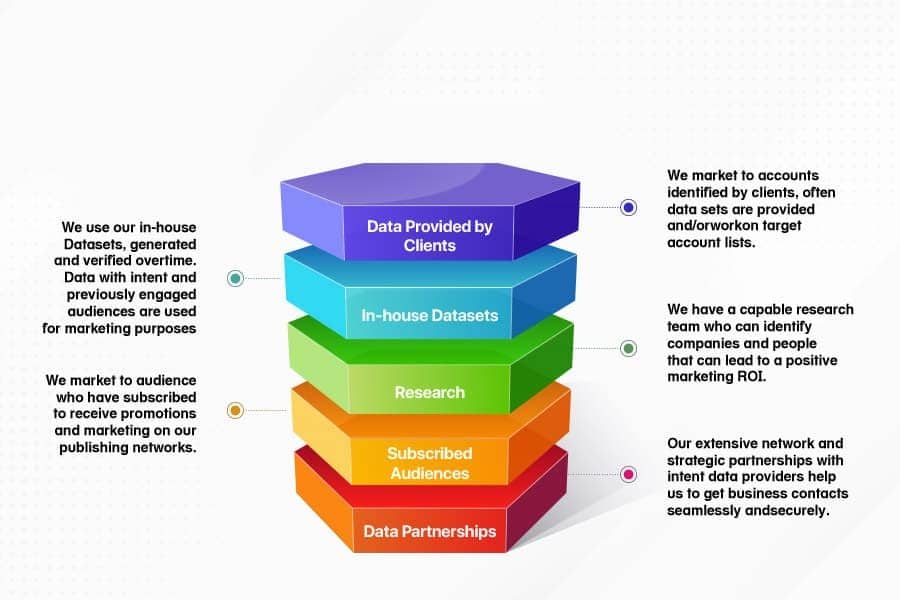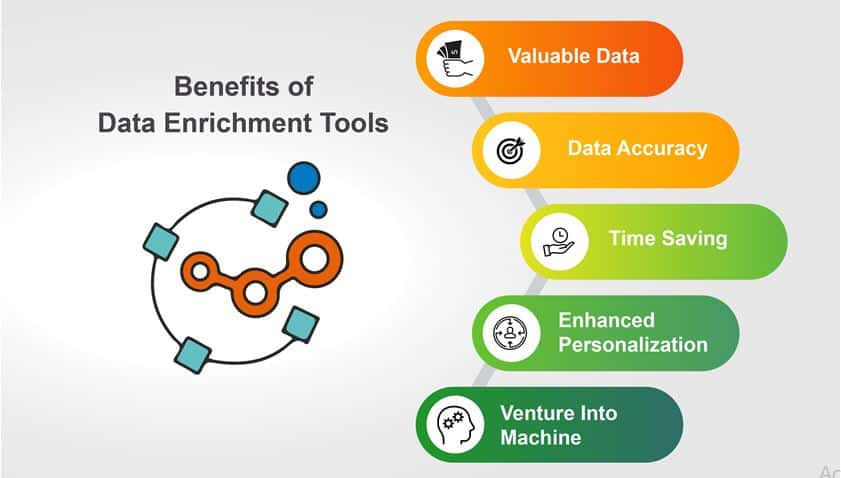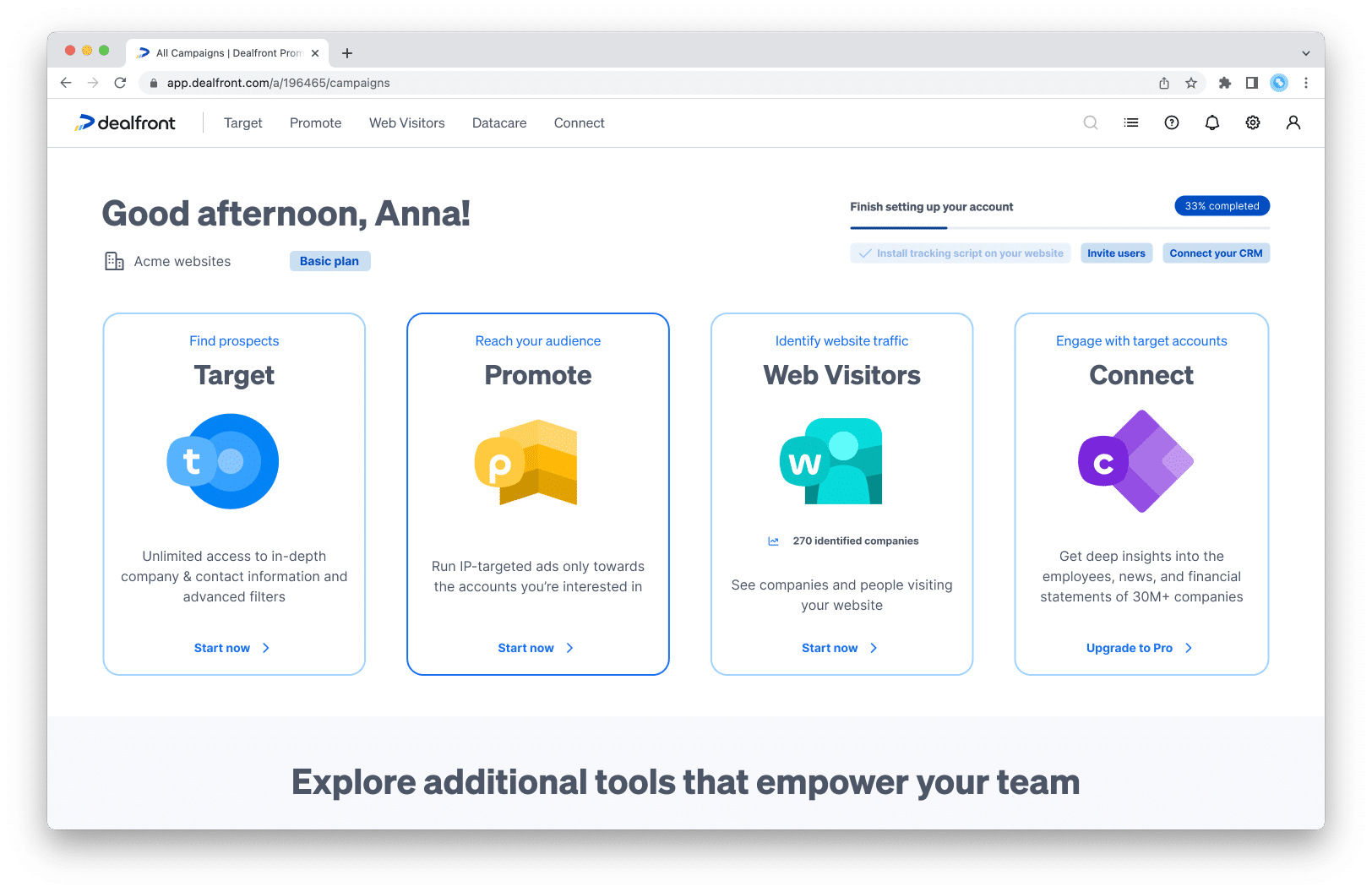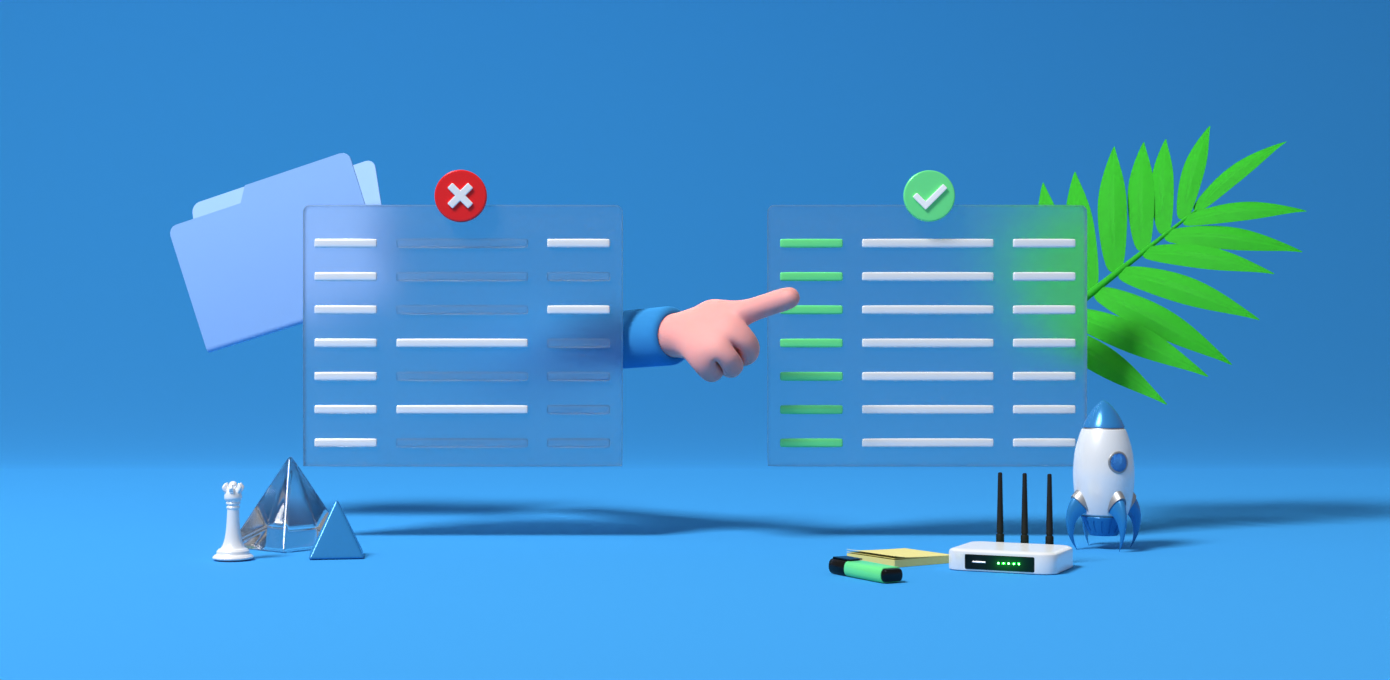Companies collect data just as squirrels collect nuts. Unfortunately, most data will often be stored somewhere and is just as quickly left forgotten and unregulated. Yet, unlike buried nuts, trees do not grow out of old data. With just a little data enrichment, you can ensure your old data sets can blossom and can use your existing B2B data in a completely new way.
What's Data Enrichment in B2B?
Data enrichment in B2B sales and B2B marketing means expanding your existing B2B data for clients, prospects, etc., for additional relevant information. Most companies use a central location such as a CRM system to gather and save all client and prospect data.
But who hasn't been there before? You search up one of your data records and the company address is missing. You've now got to guess the company sector, and your contact person for this company left the firm a long time ago. Then a lead comes up, unfortunately without a phone number and a valid email address. This makes it almost impossible to get a response.
How much more effectively could you work if you already had all the necessary data in front of you and you didn't have to search for it? This is exactly what is meant by data enrichment—completing existing B2B data with relevant data such as social media channels, company sectors, websites or sales trigger events.
The goal is to be able to access all the right and complete data records containing all the information you need for your day-to-day work.
What is Data Enrichment in B2B Used for?
Data Enrichment in B2B is used to improve your sales and marketing activities in B2B. Usually, when a fresh lead comes in or when you want to improve your data points in your CRM, there is not much information given. Especially in lead forms, you mostly only get a name and a company—but you need to append more to the given data to make the most out of it.
Data enrichment in B2B also helps your pre-sales or marketing teams or others to qualify leads. A name does not really tell you if a lead is worth reaching out to. But if you enrich the lead data with more information, you’ll see if a company fits your Ideal Customer Profile (ICP) or not.
Which Data You Should Enrich in B2B?
A company's data record usually consists of the its core information. With this data you can distinctly identify a company and correctly assign the remaining data:
Company name | Squirrel AG |
Address | 5 Acorn Street, AC0 RN1, Treeville |
Telephone number | |
Email address | contactus@squirrelag.com |
You can now expand the master data as you wish. For example:
Website | www.squirrel.ag |
Social media | |
HR number | HRB12345 Treeville |
VAT identification number | DE123456789 |
Sectors | Import, Export |
Founding year | 2000 |
Beyond this basic information, further information according to department is pretty helpful. For example, the sales department and especially sales reps could find indications of current needs of a company useful. This information is of great use for targeted outreach and you can usually find out such information through current events and news about a company. Further interesting information also includes financial figures, number of employees or web technologies that the company uses (e.g. shop systems, analytics tools, ...).
Sales Trigger Event | Change of Management (3): ...new CEO at Squirrel AG... (more) ...is looking for a new Head of Marketing.... (more) ...under new HR team lead... (more) New development plans (1): ...Squirrel AG is planning its new headquarters... (more) |
Financial figures | Profit: Turnover: |
Number of employees | 101-500 |
Web technologies | Google Analytics Java WordPress PayPal |
Details for a contact person such as name, job title, department and contact possibilities are also important so that you can approach an interested party.
Contact person | Ms Erika Nut (CEO) Email: nut@squirrelag.com Phone: LinkedIn: linkedin.com/in/erika-nut/ Mr Martin Kobel (Head of Marketing) Email: kobel@squirrelag.com Phone: LinkedIn: linkedin.com/in/martin-kobel/ |
Company Data vs Contact Data
Both company and contact details are part of every complete B2B data record. Compared to general company data, contact details for potential decision-makers are more sensitive in terms of data protection and, for the most part, are trickier to get hold of. In these cases, you must be careful how you store and use data. Where storing data is concerned, GDPR comes into play and, when using data (for example in B2B cold calling), the Act against unfair Competition (German: UWG), too. Make sure to inform yourself before you use contact details!
How Do I Obtain High-Quality B2B Data to Expand My Data?
So much for the individual data types—now, of course, the question arises: Where can you get this data from?
Essentially, there are two possibilities to collect B2B data:
- Merge all internally available data together
- Purchase external data (via tools, data brokers, third-party data etc.)
- Transfer address lists
- Automate via interface

Source: www.b2bresolute.com
A good data source in B2B is key! The first option is always useful if data for customers, interested parties, suppliers or other companies is stored in various places within the company. A consistent data bank does not just aid transparency, but also makes information accessible to all, and is the best foundation for further data enrichment.
Usually, even after such a merging of data, there are still many gaps left to be filled. Such gaps can be filled most easily by reverting back to external providers and buying data. These providers could be credit bureaus, list brokers or sales Intelligence software providers like Dealfront for instance.
Tangent: What is Sales Intelligence?
Sales intelligence means a series of digital tools that help you automate your sales and make it work more efficiently. Generally, sales intelligence works based off of artificial intelligence and machine learning. This type of software can therefore save you lots of research time and ensures that the data you obtain is always up-to-date, compliant and complete. But: A sales intelligence tool can sometimes even be considered a data enrichment tool. Find out more in our article on sales intelligence.
Enriching CRM Data
CRM systems have long been a hot topic—but as a key example they deserve their own section. Most of the time, unfortunately, the advantages of CRM systems are not fully exploited because there is simply a lack of data quality. Incomplete data records, outdated telephone numbers, no contact data…does this sound familiar? This is why it becomes difficult to maintain customer relations, much less to win new customers.
Our tip:
Where data enrichment is concerned, data cleansing is never far behind. The enrichment process usually also reveals erroneous data and duplicate data records which can be cleansed at the same time.
It is important to remember that a CRM system is a “live” tool. This means that work is usually done from many different angles; new data records are being created, existing ones are edited, and old ones are deleted. There is also a lot going on in the background: Companies grow, move, employees change, etc.
To put it simply: You won't get far with a one-off data enrichment. To keep your CRM system above water, you should seek to find a long-term data maintenance and enrichment software. From a technical point of view, this can be set up via an interface. Alternatively, CRM systems also offer integrations that may not automate data enrichment processes but can at least provide access to up-to-date data.
Enriching Leads
In B2B lead generation, the biggest goal is to generate as many leads as possible, but your sales department will quickly complain if they do not bring the necessary quality. But how can you tell the quality of a B2B lead? As a general rule, you can only tell how valuable a lead is for you when you have enough data available for that particular lead. A mere name and work email address are rarely sufficient to make a judgement.
You probably know that you should keep lead forms rather minimalistic so that the barrier for your prospect to fill in a form is as low as possible. But how can you tell if a lead is suitable? With the help of data enrichment, you can find out more about your contact. For example, enriching your data helps you with data such as department, position as well as what important information there is to know about their firm. This doesn't just simplify your lead scoring process, but also provides your sales team with important insights.
By the way, lead scoring itself is also a form of data enrichment. Self-calculated scores also add value to the data set as internal information!
Enriching Address Lists
Sometimes you might only work with individual mailing lists—for a postal B2B marketing campaign, for example. In such cases, the mailing addresses should of course be complete and correct, otherwise any associated costs will go to waste. And here, every data field is crucial—from the company name to the house number. That's why you should check your mailing list for gaps and not just work with your list from the previous year.
It is best to thoroughly cleanse and enrich the data in your lists shortly before use. For example, you can upload your lists to a sales intelligence provider and have it enriched automatically. Or, you can use such a tool to directly create a new address list with your current target audience and all relevant data. This example shows that sometimes it can be useful to enrich an address list for one time only as well.
Enriching Contacts
We've already briefly touched upon this point. Two types of enrichment can be understood under the term "enriching contacts". One meaning is to add missing information such as phone numbers, social media profiles, salutation, etc., to already existing contacts. The second meaning is to add missing decision-makers to company data records.
One thing is clear: A personal approach only succeeds with contacts. This is true for marketing and sales, as well as for customer care. If you only contact reception via a general number or email, you'll have little chance of success.
However, contact data also means personal data, and this is where the GDPR alarm bells start to ring. So, make sure to pay attention to data protection regulations!
Is Personal Data Enrichment Compliant with GDPR?
The answer, as with so many data protection issues, is not entirely clear: It depends. In fact, it depends mostly on where the data comes from, and which data is concerned.
As a rule, you can invoke legitimate interest if you only enrich data that is publicly available—such as contact information provided on the company website or in job advertisements. The data should also be business-related. A quick example: Using a work email to enrich data is ok but using a private email without specific consent is not.
There are also certain obligations that the GDPR prescribes when dealing with personal data, such as the duty to inform (see article 13 GDPR). If you'd like to find out more about this, take a look at our article.
Why is Data Enrichment Important in B2B?
Apart from the obvious advantage of having complete and correct B2B data as a basis for your work, data enrichment has other positive effects on your daily work.
Data Enrichment in B2B Saves Costs
You can save on several fronts at once and that is noticeable. Fake and incomplete data cause direct and indirect costs: Your messages go straight into the abyss (scatter loss!) or you don't reach important prospects and customers, to name just a few examples. In turn, this leads to a loss of turnover.
Even personnel costs are saved through data enrichment, as sales and marketing departments etc. must no longer waste their valuable time with manual research and data maintenance but can instead concentrate on their essential and profitable work.
B2B Data Enrichment Helps Improve Customer Satisfaction
With complete and correct data, you can be sure to always contact the right people, recognize important events with customers and congratulate them on an award, for example. You can provide needs-based advice and recognize changing requirements, for example when the team grows, or the client's liquidity decreases.
Thanks to data enrichment, you can actively approach customers and maybe even prevent terminations at an earlier stage. Or perhaps you can even identify cross-selling and upselling potential?
Data Enrichment in B2B Enables More Effective Marketing Campaigns
The more data for prospects you have, the sooner you can identify their needs and adjust the content of your messages. Send out personalized and target audience-specific messages.

Source: www.martechlive.com
High-quality B2B data also helps you to narrow down your target audience and thus increase your success in acquiring leads which fit precisely.
Can I Enrich B2B Data Automatically?
It sounds very time-consuming to have to regularly purchase data and import it manually. But don't be discouraged! This isn't the only way to enrich B2B data. It's much easier and much more effective to enrich your data automatically.
CRM systems already offer integration solutions of sales intelligence solutions in their web stores, which can be used to enrich B2B data records easily and with just a few clicks. For individual solutions, many digital data suppliers offer interfaces in the form of an API or web services that you can use to connect your system directly.
This way, your data is constantly updated and completed virtually in the background. How this exactly works depends on your use case.
What requirements should be met for automated data enrichment?
First of all, you should be clear about which data you want to enrich in the first place, i.e., which data is really relevant for you. Here you can distinguish between data that is really important and data that is just "nice to have".
Next, you should find a provider and check them carefully to see if they fit to you and your use case. This means:
- Can they provide all the data that you need?
- Are there suitable connection options or interfaces for automation?
- Are all the legal requirements fulfilled, e.g., is the provider GDPR compliant?
- How current is the B2B data provided?
Once you have found a provider, you can also clarify the details. For example, you can start with the data that should already have. Which data fields must be filled in so that the data you enrich can be clearly assigned to a data record? Is standard information such as the company name and registered office sufficient here? And which other fields can you enrich?
As soon as these data fields have been clarified, you should also define which other data fields should be enriched and ensure consistent naming so that you can correctly assign the B2B data records and match them with the data you already have.
Before we can get to data matching, it can be useful to cleanse your existing data first. Depending on your provider, you may even be able to combine data cleansing and enrichment in one simple step. The purpose of data cleansing is to ensure that the data to be enriched can be correctly allocated and that no duplicates are created if, for example, a company is not recognized due to incorrect spelling.
Tools for Data Enrichment in B2B
You might wonder: “Are there data enrichment services or something similar I can use?”. Yes, there is! We’ve collected some enrichment providers, that will help you enrich your data in a simple way.
Dealfront
With Dealfront’s Sales Intelligence Platform you will not only be able to speed up your B2B lead generation in a completely GDPR-compliant way, but you’ll also get help enriching your old CRM data and new B2B leads. See your potential customers and benefit from up-to-date firmographics!

Dealfront Dashboard
Furthermore, Dealfront turns your website visitors into leads and selling opportunities. Plus, it will support you with enriching your leads, too. If you want to boost your sales and optimize your workflow in the easiest way possible, try their solution.
Clearbit
Clearbit is a demand generation and management software that helps you defining your ICP. As a data activation platform it shows you many facts you need to know about your market.
Use Case: Enrich B2B Leads with Dealfront and Zapier
As a sales intelligence provider, Dealfront has current, relevant and GDPR-compliant B2B data available. As part of this example, we want to show you how you can enrich your B2B leads, save time and improve your KPIs in lead management in the long run.
For this, we use the Zapier integration service. Zapier makes it comparatively easy to create interfaces between different systems and tools. Since Zapier offers over 4,000 apps, there is a high probability that you can also find a zap for your lead forms.
Tip: For data enrichment directly in CRM, Dealfront also offers CRM integrations for many popular systems. Before you start, you should be aware of the following things:
- which data you ask for in the lead form/when generating leads,
- which data you would like to have added during enrichment and,
- which systems are involved (lead generation, connectivity, enrichment and data management/CRM).
Example 1:
The company Müller uses the CMS system WordPress and generates leads via inline forms on the website. Only an email address and a company name are requested. Dealfront can now enrich the information with...
- The name of the contact
- His/her position
- His/her telephone number
- Company selector
- Current sales trigger events
And then it's to be imported into the company's own CRM system.
Once this has been decided, first check whether you can find the appropriate apps in the Zapier App Store. If in doubt, you can get in touch with Zapier directly because not all apps are listed in the Zapier App Store.
Example 2:
The responsible PreSales Manager sets up the interface in Dealfront with the help of the IT department and their Dealfront consultant.
Depending on how far your lead generation has already been automated, additional steps may also be necessary. In the end, the following process should be established:
Lead goes into Zapier > Dealfront (matches & enriches data) > Zapier > CRM
Example 3:
From now on, all incoming leads are automatically enriched with B2B data via Dealfront and imported into the CRM system. The PreSales manager saves a huge amount of time: From now on, your only job is to check the leads as quickly as possible, qualify them and distribute them to the sales department.
Conclusion: Why (Automated) B2B Data Enrichment is the Best
You probably already knew the one key takeaway from this post: Up-to-date and complete B2B data is important! Now you know that it's worth it to take care of it. And let's be honest, would you have thought you'd be able to derive so many benefits from your customer data with so little effort? Automated data enrichment saves time, is easy on the company wallet and on your nerves.
With sales intelligence, data enrichment is no longer permanently on your to-do list. For example, if you access Dealfront's database directly, you automatically get the latest publicly available information on over 20 million companies and more than 60 million employees from across Europe. Thanks to the numerous integration options, you can also use Dealfront to keep internal systems such as your CRM up to date.
In addition, Dealfront provides you with more than just standard: Enrich even more exciting data such as turnover, annual financial statements, shop systems used, shipping service providers and even sales trigger events such as management changes or job cuts.
Enrich your B2B data and notice the difference!
